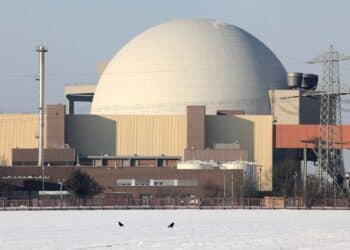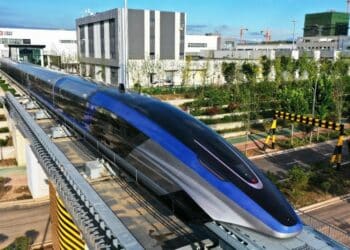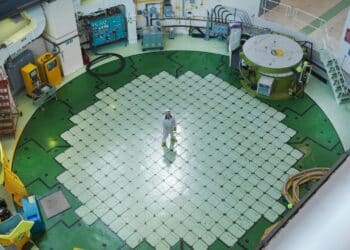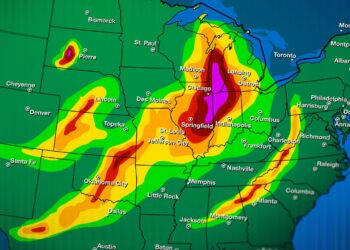News
Our News category at Global Current News provides fast, reliable coverage of breaking events and key developments worldwide, including in the United States. From political decisions and economic shifts to cultural milestones and scientific breakthroughs, our skilled journalists bring you the latest reports with precise, concise analysis. Stay informed and connected to the global conversation with up-to-the-minute updates.
Fuel prices may be lower after QatarEnergy’s latest statement
On QatarEnergy's official announcement dated December 31, 2025, concerning Qatar's petrol prices for January 2026, it was stated that prices...
Read moreDetailsIter’s giant fusion reactor in southern France hits a major assembly milestone with vacuum chamber module 5
Inside a concrete pit near Cadarache, engineers have positioned ITER’s fifth vacuum vessel module—an ultra-precise step that brings the world’s...
Read moreDetailsChina’s two-second maglev burst to 700 km/h hints at what the next generation of trains could look like
A superconducting maglev test rig in China accelerated from 0 to 700 km/h in just two seconds on a 400-metre...
Read moreDetailsEconomic pressures fuel widening protests across multiple cities in Iran
Protests are erupting across dozens of cities in Iran as the country experiences the worst unrest it has seen since...
Read moreDetailsGoing a mile underground to run a nuclear reactor: why Deep Fission says rock pressure could replace giant domes
A US start-up is pushing an unusual idea for small nuclear power: drop a conventional pressurised-water reactor into a narrow...
Read moreDetailsUnder Norway’s North Sea, a 600‑meter‑deep desalination capsule could reshape how cities get drinking water in 2026
A submerged desalination project off Mongstad, Norway, plans to use deep-ocean pressure to push seawater through reverse-osmosis membranes—aiming to cut...
Read moreDetailsFrance ships a 500-tonne reactor vessel to Hinkley Point C as Britain’s new nuclear era takes shape
A 500-tonne reactor pressure vessel forged in eastern France is heading to Somerset, where it will become a central part...
Read moreDetailsAt 5,600 metres in the Kunlun mountains, China is using driverless trucks to unlock a €45 billion lead-zinc prize
In the thin air of Huoshaoyun—where cold, altitude and logistics make conventional mining punishing—China is leaning on autonomous haul trucks...
Read moreDetailsUnited States begins military action in Venezuela and detains President Nicolás Maduro
One of the biggest diplomatic and military crises of recent decades has just occurred between the United States and Venezuela....
Read moreDetailsDelcy Rodríguez takes office as Venezuela’s new leader as international tensions intensify
Delcy Rodríguez was sworn in as Venezuela's acting leader on January 4, 2026, marking a major change in Venezuela's political...
Read moreDetailsNorth Korea fires ballistic missiles ahead of South Korean president’s planned visit to China
Pyongyang launched multiple ballistic missiles into the East Sea on January 4 at 7:50 a.m., just hours before South Korean...
Read moreDetailsUnited States widens visa restrictions and raises immigration fees for travelers from 39 countries
The political landscape of the United States is facing some changes, especially the country's immigration policy, which is entering a...
Read moreDetailsBulgaria formally joins the euro area, becoming its 21st member
Beginning January 1, 2026, Bulgaria will start using the euro as its main currency, making it the 21st country to...
Read moreDetailsEurope begins phased deployment of the new Schengen entry–exit system at major airports
Recently, the European Union initiated the launch of a number of large-scale airports within the Schengen region to begin rolling...
Read moreDetailsDeadly blaze at a Swiss ski resort bar leaves at least 40 dead and more than 115 injured
According to reports from PEOPLE magazine, a fire that took place in the Swiss Le Constellation bar in Crans-Montana during...
Read moreDetailsLithuania introduces language requirement obliging foreign residents to serve the public in the national language
Lithuania has made an important decision regarding the use of its official language in the daily lives of its population....
Read moreDetailsUnited States rolls out broad new visa restrictions and raises travel-related fees
The United States is expected to begin 2026 within a comprehensive framework of travel and immigration reforms that will include...
Read moreDetailsScientists are stunned: 8 new spacecraft images reveal interstellar comet 3I ATLAS in such unsettling detail it doesn’t look real
The astronomical community is in a state of shock following the release of a new set of eight high-resolution spacecraft...
Read moreDetailsA historic early-season polar vortex shift is surging, and experts say its intensity is unmatched for January
Meteorologists are currently monitoring a massive atmospheric anomaly as a significant disruption of the polar vortex begins to take shape...
Read moreDetailsWTTC selects Valletta to host its 2026 global summit, highlighting sustainable tourism goals
The city of Valletta, in Malta, has been chosen by the World Travel & Tourism Council (WTTC) to host the...
Read moreDetailsSix minutes of darkness: Get ready for the longest eclipse of the century that will turn day into night
Imagine that, in the middle of lunch, the sky begins to take on a metallic tone, the birds fall silent,...
Read moreDetailsColombia to host first global summit dedicated to phasing out fossil fuels in April 2026
Colombia has made climate diplomacy history by becoming the first nation to organize an international summit on the global phase-out...
Read moreDetailsIOM warns looming budget cuts could jeopardize core programs in 2026
The International Organization for Migration (IOM) has issued a worrying warning about the international migration scenario, which concerns a forecast...
Read moreDetailsUNCTAD to host 2026 investment forum in Qatar aimed at addressing global economic fragmentation
The UNCTAD has disclosed details of its upcoming 9th World Investment Forum (WIF), which will occur in Doha, Qatar, in...
Read moreDetailsG7 leaders to convene in Évian-les-Bains in June 2026 as economic and climate pressures intensify
From June 14th to 16th, 2026, the French city of Évian-les-Bains will be in the global spotlight due to the...
Read moreDetailsWTO warns rising U.S.–China trade friction could intensify heading into 2026
With the approach of 2026, the World Trade Organization has issued a dire prediction to the globe. The prediction warns...
Read moreDetailsNATO selects Ankara to host its 2026 summit amid heightened focus on the eastern frontier
NATO's 2026 summit will be held in Ankara for the first time, which, in addition to raising the level of...
Read moreDetailsRiyadh prepares to host global defense exhibition in February 2026 amid growing strategic ambitions
Saudi Arabia will hold the third installment of the World Defence Show (WDS), to be held in Riyadh from the...
Read moreDetailsIOM cautions that deep budget cuts could disrupt key migrant programs in 2026
The International Organisation for Migration (IOM) has already issued a warning that also serves as a cause for concern for...
Read moreDetailsAntigua and Barbuda chosen to host 2026 Commonwealth Summit, boosting small-island climate diplomacy
Antigua and Barbuda will be hosting the Commonwealth Heads of Government Meeting (CHOGM) in 2026, marking a significant milestone and...
Read moreDetailsColombia to host first global summit on phasing out fossil fuels in April 2026
It has been announced that Colombia will host the first global summit dedicated to phasing out fossil fuels in April...
Read moreDetailsNew era for the blue planet: America and 140 other nations are finally coming together to save the deep sea
On January 17, 2026, the first legally binding international treaty to protect marine biodiversity on the high seas will come...
Read moreDetailsChina selects Shenzhen as host city for 2026 APEC summit
China's choice of Shenzhen as the host city for the APEC Leaders' Summit, an event to be held in 2026,...
Read moreDetailsUN General Assembly schedules mid-2026 vote to elect five new rotating Security Council members
The elections for new non-permanent members of the United Nations' Security Council are scheduled for mid-2026. The elections will be...
Read moreDetailsMounting climate alarms ahead of 2026 as Arctic warming accelerates and carbon limits near collapse
Experts are sounding the climate alarms as the remaining carbon budget to maintain warming below 1.5°C is reduced to only 130...
Read moreDetailsAnalysts warn of possible political unrest in 2026 across Bangladesh, Nepal, and Pakistan
Forecasts for 2026 suggest that Bangladesh, Nepal, and Pakistan could face a rise in political unrest. Analysts point to a...
Read moreDetailsGlobal powers agree to convene 2026 summit aimed at reinforcing humanitarian law in conflict zones
World leaders are set to hold a historic summit in January 2026 to strengthen respect for international humanitarian law (IHL),...
Read moreDetailsEmerging influenza variant strains hospitals across Europe and stresses public health capacity
This year, the first flu season to have collected data across the entire region is putting a strain on the...
Read moreDetailsTensions flare again along the Cambodia-Thailand border following renewed clashes and troop movements
On December 8, Thailand and Cambodia exchanged fire in many contested sectors. Most significantly the Preah Vihear and Oddar Meanchey...
Read moreDetailsCyclones Senyar and Ditwah drive deadly flooding across multiple parts of Southeast Asia
The overflow of Cyclones Senyar and Ditwah, multifaceted storms with rare nature and phenomena, triggered significant landslides and floods affecting...
Read moreDetailsItaly hails UNESCO decision to recognize Italian cuisine as part of world cultural heritage
A UNESCO listing in India (New Delhi) for Italy’s full body of cuisine at the 2023 20th session of the...
Read moreDetailsUN high seas treaty to enter into force in early 2026, ushering in new ocean governance era
The world is on the verge of watching the birth of a completely new era in the governance and protection...
Read moreDetailsWorld Bank trims East Asia-Pacific 2026 growth forecast to 4.3%
The World Bank announced in October that it had made a new economic projection, which generated comments about the pace...
Read moreDetailsU.S. secretary of state to tour Central Asia in 2026 amid push for deeper resource cooperation
During a reception at the State Department on November 5, where U.S. Secretary, Marco Rubio hosted the foreign ministers of...
Read moreDetailsPortugal’s constitutional court strikes down core provisions of the government’s new citizenship law
Portugal's nationality law has been amended numerous times since it was enacted in 1981. These amendments reflect the current political...
Read moreDetailsDemocratic Republic of the Congo declares end of Ebola outbreak after weeks with no new cases
After a series of weeks without reported cases of the Ebola virus, the Democratic Republic of Congo announced it had...
Read moreDetailsNationwide walkout disrupts Portugal as opposition to labor-law changes escalates
Proposed changes to labour laws have resulted in Portugal experiencing its first general strike in 12 years. Walkouts at millions...
Read moreDetailsTrump administration broadens U.S. travel restrictions, barring supporters from Senegal and Ivory Coast ahead of the 2026 World Cup
The United States, through an Executive Order, is expanding its previously announced Travel Ban in order to include two new...
Read moreDetailsSudan returns to the top of global humanitarian emergency rankings as conditions deteriorate
The International Rescue Committee (IRC) has added Sudan to its watchlist. The report, published on 16 December, shows the correlation...
Read moreDetailsIndia deepens diplomatic ties with Ethiopia as Prime Minister Narendra Modi visits Addis Ababa
Prime Minister Narendra Modi began a historic first visit to Ethiopia this week, marking the beginning of a new era...
Read moreDetails


















































